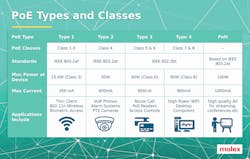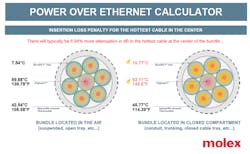PoE Classes
Power is injected into an Ethernet cable at a voltage between 44 and 57 volts DC. This relatively high voltage allows efficient power transfer along the cable, while still being low enough to be regarded as safe for users. However, it can still damage equipment that has not been designed to receive PoE. Therefore, before the PSE enables power to a PD, a power negotiation / classification sequence is performed.
There are 8 PoE Classes, plus Class 0 (unclassified). The Class reflects the lowest power level that can be supported by both the PSE and PD, and is determined during the classification “handshake” procedure.
The aim of PoE negotiation, and the entire Class system, is to ensure the amount of power delivered is what is required. It is a common misconception in PoE that power is “pushed” down the cable irrespective of the device/s at the other end. In reality, a lower-Class device - or even an unpowered device - can be attached to a PSE with higher power potential without risk of oversupply. Each subsequent PoE release incorporates the previous Classes, so that while IEEE 802.3af incorporates only Classes 1-3, IEEE 802.3bt (Type 4) incorporates all 8.
PoE Types
PoE Types are based on the Standards that describe them, the number of cable pairs that are energized, and the voltage.
Type 1 PoE, Standardized in IEEE 803.2af, delivers power on two cable pairs to provide a max current of 350mA.
Type 2, IEEE 803.2at, also uses two cable pairs and provides up to 600mA / 30W.
IEEE 802.3bt, which includes both Type 3 and 4, enables power to be carried on all 4 pairs of twisted-pair cabling, making it possible for up to 90W to be provided at the PSE (and 71W at the PD). Type 3 delivers 600mA and up to 60W at the PSE, while Type 4 delivers 960mA and up to 90W at the PSE, depending on the PoE Class.
As previously mentioned, PoE Standards are backward compatible, so Type 1 or Type 2 devices can be attached to a Type 4 PoE network without trouble. However, it’s unlikely that a Type 4 device would be able to draw enough power from a Type 1 or 2 network to operate.
Remote Power (RP) Categories
PoE Types and Classes exist to ensure the components within a PoE network can negotiate, deliver and receive the correct amount of power. In contrast, Remote Power (RP) Categories are designed to address installation practices.
The three RP Categories were defined in 2020 by International and European Standards (ISO/IEC 14763-2 and EN 50174-2). RP Categories are defined around the average current served by the distributor. RP1 covers the lowest current applications, where the average current (ic-average) across all conductors served by the distributor is not greater than 212mA; RP2 covers 212mA to 500mA; and finally, for Category RP3, attachment of a PSE or a PD at a distributor is unrestricted subject to the limit of Ic < 500mA. But still, good upfront planning is required, together with documentation and administrative controls during subsequent extensions of the cabling. Therefore, all Type 4 PoE installations must adhere to RP3 by default.
The goal of RP Categories is to ensure the heat build-up from power supply is adequately managed, in situations where it might be an issue. In lower power, RP1 installations, there is minimal risk of heat build-up, so there are minimal installation or planning requirements. Conversely, higher power RP3 networks are at a much greater risk of heat build-up, which must be accounted for when designing and implementing the network.
For lower powered networks, there might be an argument that working to RP1 or RP2 will save time on planning and documentation. But while this would make the network easier to install, it will result in additional admin and documentation for the working life of the network. Every time a change or addition needs to be made, controls will be required to demonstrate that the average current will not exceed the permitted levels. With RP3, the planning is front-loaded into the initial network design, resulting in an architecture that is much easier to manage moving forward. Attachment of remote powering equipment at a distributor is unrestricted, subject to the limit of ic<500mA.
An RP category applies to an entire cable bundle. To mix cables suppling 15W Type 1 and 55W Type 3 PoE in the same bundle, for example, the average current of the bundle as a whole would determine the minimum RP Category.
So even if the initial install were only intended to supply low power, Type 1 or Type 2 PoE, it may be more prudent to work to RP3 compliance. This will depend on the long-term goals for the network and, as always, objectives should be clearly defined upfront.
It is also recommended that a consistent Category is applied to all distributors at which remote powering is applied.
Likewise, where the installation specification describes an extension to existing cabling, the RP Category of the existing installation must be specified.
Finally, specific labelling is required – it is recommended to have labels both on the cabinet AND on the distributors (or patch panels).
Getting it right in the field
In order to help Designers, Consultants, Installers and End-users, Molex has created a series of electronic tools, including a PoE Calculator which includes all of the PoE equations and formulas, including RP Categories. This makes it easy to ensure the Standards for product, design, installation, configuration and testing are followed.
About Molex Connected Enterprise Solutions
With more than three decades of experience delivering enterprise network solutions for some of the largest organizations in the world, Molex Connected Enterprise Solutions delivers superior infrastructure solutions to power the future of intelligent buildings. Our global team of experts will work with you at every step to develop a comprehensive solution.
More information
Molexces.com


